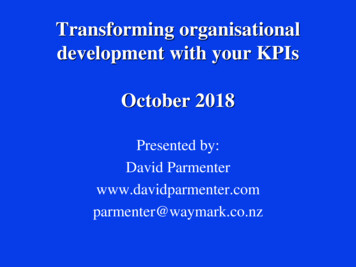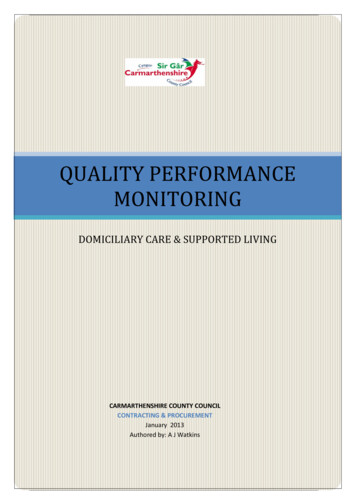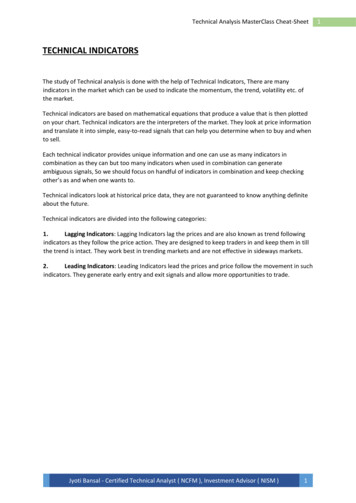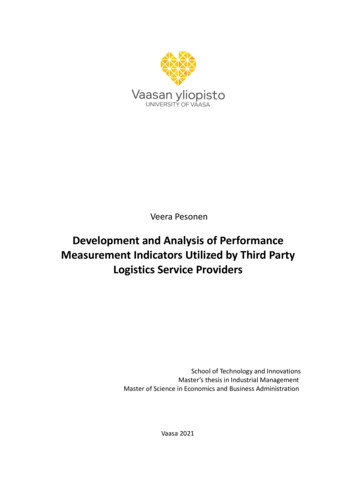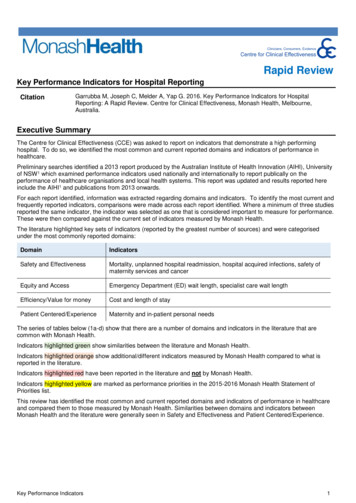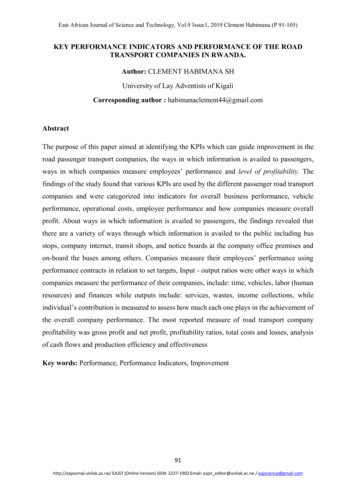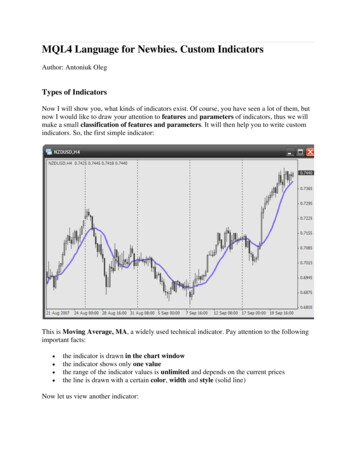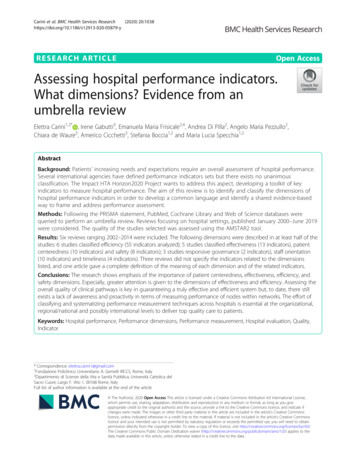
Transcription
DEVELOPMENT OF QUALITY PERFORMANCE INDICATORSFOR QUALITY MANAGEMENT IN CONSTRUCTIONPROJECTS12Sang-Hoon Song , Hyun-Soo Lee , Moonseo Park3song17@snu.ac.kr , hyunslee@snu.ac.kr , mspark@snu.ac.kr 3Dept. of Architecture, Seoul National University12ABSTRACTThe growing competitions among companies intensified by the rapid changes inbusiness environments are forcing them to adopt a new managerial paradigm. Thetraditional production-oriented management focusing on higher productivity hastransformed into the customer-oriented management aiming at achieving customersatisfaction. Under these circumstances, quality management is one of the criticalconcepts for innovating corporations and improving their competitive edge. Despitethe companies’ recognition of the significance of quality, most of them do not have asolid basis for quality management and substantial action programs. In theconstruction industry, there have been many attempts to adopt quality management asa tool for continuous improvement. They include Six-Sigma which has already beenproven to be very useful for fostering quality innovation in the manufacturing industry.But these kinds of efforts are not sufficient enough to achieve organizational goals inquality management. It is essential to also take into consideration the root causes ofinefficiency in the quality management.The low level of construction quality is mainly caused by the result-oriented qualitymanagement owing to the fact that quality problems can be detected only after theyoccur. Also, few systems provide the quality managers with numerical objectives ortangible goals.This study suggests a data-based quality management as a solution to the foregoingproblems and discusses the methods of measuring and analyzing the performancerelated to quality in a construction company. It establishes the quality indicators tomeasure quality performance objectively. The management objectives and CSFs aredefined according to the three management levels: strategic level; project level; andoperational level, and then the indicators to measure and manage them are listed. Theindicators are assigned to each quality management level and the level of quality isexpressed with Sigma values. Through this quality performance management,managers will be able to improve the construction quality by monitoring the majorindicators of construction project success and ultimately increase the competitivenessof overall construction organization.Keywords: Performance, Performance Indicators, Quality, Quality management1. INTRODUCTIONThe shifts in business environments have intensified competition among companies,310
forcing them to adopt a new managerial paradigm. The production-orientedmanagement that focuses on higher productivity is changing to a customer-orientedmanagement focused at customer satisfaction. Under these circumstances, quality isone of the critical factors to increase their competitiveness, and quality management isone of the main issues for improving competitive edge of innovating corporations.However, most of the companies do not have a basis for quality management andsubstantial action programs even though they recognize the significance of quality.Until now, quality has not been a priority factor considered in the construction projectlife cycle compared to other project management factors such as cost and schedule.Quality should be perceived as a critical success factor and be analyzed from a newperspective that considers the relationships with traditional key success factors in theconstruction industry. Recently, there have been increasing attempts to adopt qualityas a tool for continuous improvement like Six-sigma which already proves itsusefulness for quality innovation in manufacturing industry (Pheng 2004). Theaverage level of quality of construction industry is comparatively lower than otherindustries like the textile and clothing industries and the electronics industry. The lowconstruction quality is mainly attributed to the practice of result-oriented qualitymanagement.This paper introduces some quality indicators for measuring quality performanceobjectively and with which to develop a quality performance management system tomonitor the construction quality continuously. Through the quality performancemanagement, managers will be able to improve the construction quality by monitoringthe leading indicator that determines the success of a construction project andultimately increase the competitiveness of the overall construction organization.Quality management should be implemented in a more quantified and integratedmanner to advance to higher managerial level as discussed in project managementprocess maturity model (Kwak 2002). This paper suggests a method of measuring thequality level of project and enterprise by aggregating the quality of the respectiveworks and materials, which is the lowest unit of quality management.The scope to which the concept of quality can be applied in a construction companyranges from the management quality using TQM to the quality of material or labor onconstruction field. And quality data classified according to managerial levels shouldbe aggregated and manipulated by those levels.This paper limits the research scope to the quality of activity during the executingphase of the construction project. Among the quality concepts that shows diverseaspects according to project phases or customers by the delivery systems, thedefinition of quality is determined as "conformance to specification" in this paper.Subsequently, the degree of achieving construction quality of "conformance tospecification" is defined as quality performance. The processes and results of thisquality performance were analyzed with suggested indicators from the perspective ofthe main contractor undertaking overall field management during the constructionstage.This research was executed according to the following procedure. 1) Review thecurrent status and problems of the quality management in construction project through311
literature review and establish the solution to them. 2) Analyze quality managementprocess, and identify the problems and critical points in measuring and analyzing thequality performance. 3) Discuss the characteristics of performance indicators andsystems, and develop the quality performance indicators linked to organization'sstrategies and quality objectives. 4) Find the data collecting method according to theestablished indicators, and plan the architecture for continual quality dataaccumulation. 5) Develop construction quality performance management process2. QUALITY IN CONSTRUCTIONQuality management, which is a concept that had referred to simple inspections in theearly 20th century, has continued to evolve to TQM, Six-sigma, and so on. Recently,quality places emphasis on the strategic direction, systematic approach, andorganizational efforts.There is a difference between a producer’s perspective and customer’s perspectivewith respect to quality. Quality from the producer’s perspective is the quality ofconformance, making sure that a product or service conforms to the described designstandards and quality specifications. Normally the design activities, the starting pointof quality management, are completed before the products are manufactured, anddesign standards and quality objectives are set up according to the corporate strategyand customer needs. To assure that the quality is maintained throughout the wholeproduct life cycle and not confined to a simple product quality, quality of goalachievement and quality of conformance to meet the specification can be applied forthe construction project management.According to Ledbetter (1994), quality is defined as the conformance to theestablished requirements and the requirements are regarded as the characteristics ofproduct, process, or services specified by the contracts.Quality Management ProcessPrior to developing the quality performance indicators and continuous measurementsystem, the currently used quality management process should be analyzed as apreliminary work. Quality performance management practice, related organization,and incurred data can be reviewed during this process analysis.Quality management process of the main contractors in a construction project iscomposed of four sub-processes, and they are quality planning, quality check, qualityaction, and quality analysis. In quality planning stage, a quality management plan thatincludes quality goals and organization on the project level and inspection and testplan(ITP) on the activity level are prepared. The tests and inspections for materialsand finished works are executed according to the designated schedule in the qualityplan during quality check stage. Items requiring additional managerial efforts areidentified by the inspection results, and non-conformance reports are issued to therelated sub-contractors during the quality action stage. In the quality analysis stage,the inspection results are periodically analyzed and used to evaluate the level ofproject quality. Non-conformance items are classified along with building types,project types, or trades, and managers assess the performance by comparing actualvalues to the original goals.312
Quality inspections are classified into the factory inspection, material inspection ondelivery, work-in-process inspection(surveillance), and final inspection, all of whichhave the common process of 'planning - executing - processing'. Quality actionincludes the measures to handle non-conforming materials or works along with theprocess of 'identifying - action-taking - confirmation' as shown in Figure 1.Quality PlanningQuality Mgt PlanningInspection and Test PlanningPlansQuality CheckPlanExecution ProcessingShop Inspection/TestMaterial Inspection/TestNonConformingResultsWork Inspection/TestQuality formance ReportingResultsofActionsFinal Inspection/TestQuality AnalysisCorrective Action RequestingTrend AnalysisWorksFinishedQuality EvaluationFigure 1. Process of quality managementCharacteristics of Quality Management in ConstructionQuality management is achieved by defining requirements based on organization'svision, and executing activities to satisfy them. The quality objects to be achievedthrough quality management in construction projects vary according to various factorssuch as types of customer, project phases, participants, construction methods, and soon. These factors are determined by the characteristics of project and influence thequality management system and contents. The quality level of the construction projecttends to depend on whether proper quality control system is developed consideringproject characteristics and organizational capabilities. The quality performance shouldbe evaluated continuously based on these factors.Current quality management is focused on the results of works, and materialsscheduled to be installed. Though other resources put to activities on construction sitelike labors or equipments affect the productivity and quality (Lee 2004), normallythey are not included in the scope of quality management.The current quality assurance system does not provide a quantitative ground forquality management. For time management and cost management, time, cost, or ratiosare provided to the managers to help them perceive intuitively the managerialobjectives and status. But most of the objectives in quality management havequalitative attributes and there is no method to properly assess the quality. Qualityproblems are intrinsically difficult in detecting before they occur and they areidentified when managers confirm them (Garvin 1984). So, quality management arelikely to be result-oriented without a proper preventive system that converts quality'sresult-oriented characteristic to predictable values.The characteristic of the construction industry that it depends on the field production313
is one of the main obstacles in ensuring the performance (Kubal 1994), and CII (1994)summarizes problems of quality management in construction industry as follows.For end results rather than process steps; that is, most measurement processes area non-predictive manner of measurement. Focused on isolated phases with minimum integration. Geared toward short-term improvements vs. long-term strategic goals. Seldom developed by the full project team (owner, engineer, and contractor). Not well-suited to benchmarking. Literature Reviews on Quality Performance ManagementDavis (1989) designed QPTS (Quality Performance Tracking System) and discussedthe definition of quality, requirement analysis, and application to cost/schedule system.Ledbetter (1994) developed QPMS (Quality Performance Management System) forestimating quality costs based on labor costs. Love (2004) measured the quality costswith PROMQACS (Project management quality cost system) including problem types,related trades and organizations, quality cost types, and impact on schedule/cost. Allthese researches regard quality costs as the major indicator and discuss themeasurement of quality costs and their actual proportion to project costs.Cheung et al. (2004) developed PPMS (Project Performance Monitoring System) formonitoring quality by using the performance indicators shown in Table 1.CategoryTable 1. Quality-related indicators (Cheung 2004)Performance indicatorsInspections Non-ComplianceRecordsWork RejectionSurvey (Samples)RejectionNumber of site inspections conductedNumber of non-compliance records receivedNumber of non-compliance records closedTotal number of non-compliance records rectifiedAverage time to close out non-compliance recordsDue to workmanshipDue to latenessDue to workmanshipDue to latenessCheng et al. (2000) suggested the quality-related measures as shown in Table 2.Quality measures were developed to improve client confidence, increase clientsatisfaction, and increase construction durability, and rework is measured to reducewasted work.CriterionTable 2. Quality-related measures (Chung 2000)MeasureMeasuring unitQualityConstruction Process% sample rejectionsNumber of claims by clientNumber of claims by contractorRework MH/total MHRejection of workClient satisfactionQuality of workRework In UK providing and managing KPIs to measure and analyze the constructionperformance as a social system, quality issues are classified into three types: rejected;reworked; and compromised. The cost and time incurred to rectify quality issues aremeasured, and the sources of quality issues are also reported with the categories ofworkmanship, design/specification, defective materials, damage on site, and others.314
Existing quality management systems in practice are focused on processing the qualitymanagement tasks, and provide a simple function of generating the periodical reportsto monitor the quality status. To complement this shortcoming, various qualityperformance indicators need to be developed and settled in the performancemanagement process. Also, the process that includes identifying the causes of qualityproblems, developing necessary actions to resolve them, and establishing the goalsshould be suggested in accordance with the general framework of performancemanagement to overcome current systems’ failure to trace the root causes inperformance variation.3. QUALITY PERFORMANCE OF CONSTRUCTION PROEJCTSQuality Performance Management ProcessPerformance measurement means the process of evaluating performance relative to adefined goal, and performance metrics are defined as the analytical tools in theperformance measurement process that take measurements, display results, anddetermine subsequent action (Rose 1995).The performance measurement system in specific organization should have a balancedframework between cause and effect, efficiency and effectiveness, etc. In themeasurement and analysis of the quality performance, it is important to identify thepoints needing improvement and formulating the solutions through the indicators ableto analyze the process, taking into consideration that one of the drawbacks intraditional business is the result-oriented measurement (Pande 2001). As pointed outby Bassioni (2004), the feedback loops and subsequent decision-makings are requiredto transform measurement system into the management systems including decisionsupport functions.In the construction projects, work progress is managed with process factors while themonitoring is based on the result factors. The managers on the lower level areinterested in the process factors, while the upper management places more emphasison the measures showing results. In this sense, quality performance can be regarded asthe process measures, compared to the financial measures mainly demonstrating thecost status in the construction project.In this research, the quality performance management cycle was composed withreference to the Deming cycle which comprise the plan, do, check, and action. Thecycle comprises quality performance planning, quality performance measurement,quality performance review, and quality performance improvement. The managementlevel is divided into three levels: the strategic management; project management;operational management. The tasks of each level in conducting quality performancemanagement are listed to identify their major interests. Managers on the upper levelmust have data on matters such as cost or schedule as well as the quality to evaluatethe quality performance of the construction companies. By synthesizing all these datafrom various management areas, managers can judge the quality status from a moreintegrated perspective.The functions and tasks related to quality performance management for eachmanagement level are as follows:315
Strategic management level(S) : Review the quality management strategy andquality policy in the enterprise or department’s perspective, and monitor theoverall quality performance of the departments and sites Project management level(P) : Manage the quality assurance status, review thequality objectives and action plans, and monitor quality status of the site byanalyzing and comparing quality data Operational management level(O) : Plan the inspections and tests considering therelationships with the schedule and resource allocation, determine whether toproceed to succeeding activities, and take necessary actions to handle qualityproblems Figure 3 shows tasks and review items of the each management level along the qualityperformance management cycle.Performanc e ImprovementS Plan strategic actions Execute actionsP Plan integrated actions Execute actionsO Update inspection items Execute immediate actions toreduce quality problemsPerfor mance PlanningS Enterprise quality objective- Quality le vel of company/de partmentP Site quality objective- Quality cost ratio / quality costsO Work quality o bjective- Quality inspection / non-conform ancePLANQuality PerformanceManagementACTIONCycleDOPerformanc e ReviewS Identify quality status Review goal achieve mentPerformanc e Meas urementS Measurement per d epartment/site Data collection and aggregationCHECKP Identify site quality status Review goal achieve mentP Measurement on site level Data collection and aggregationO Identify work quality status Review goal achieve mentO Data collection Quality inspection and testFigure 2. Quality performance management cycleAfter determining the quality status, the causes for poor achievement should be tracedto improve and enhance the efficiency of quality management. This researchcategorizes the causes of quality problems into work error, design error, defectivematerial, damage on site, etc. Each inspection item is connected to the cause on theinspection checklist, and inspection results are input into the quality managementsystem in a periodic manner.Development of Quality Performance IndicatorsThe performance indicators are the objective standards developed based on themanagement policies and the critical success factors to assess the accomplishment ofthe policies in the companies.Rose(1995) suggested the attributes of good metrics, and they are summarized as316
follows. Good metrics are customer centered and focus on indicators that provide value tocustomers. They measure performance across time, which shows trends rather than snapshots. They provide direct information at the level at which they are applied, and nofurther processing and analysis is required to determine meaning. They are linked with an organization’s mission, strategies, and actions. They are collaboratively developed by teams of people who provide, collect,process, and use the data.Also, the what, why, when, how, and who to measure should be defined in developingquality-related indicators (CII 1994).In this research, the management objectives and critical success factors (CSFs) weredefined for each quality management level, and the indicators to measure and managethem were developed (shown in Table 3). The basic principles in developing qualityindicators by CSFs are as follows.Upper management identifies the quality level and performance at a glance with asingle indicator. The indicators cover the larger scopes in performance as themanagement levels are higher, and have the characteristics of financial indicator. The quality indicators are classified into effectiveness measures and efficiencymeasures. Efficiency measures are designed to measure the productivity of thequality management process, including quality cost ratio and each category ofquality costs. Effectiveness measures are calculated using the data from theinspections and tests, including work quality ratio, NCR records, and goalachievement ratio. The achievement ratios are calculated by comparing the actual performance to theperiodical quality goal for each indicator. These ratios show the effectiveness ofquality management by comparing the actual results to the achievable level. The newly developed quality indicators enable management to monitor theprocesses, and not the results, and analyze quality from various dimensions inorder to improve efficiency. Table 3. Quality objectives and CSFsObjectiveCSFsLevelStrategicLevel Customer satisfactionAssuring management qualityIntegrated quality management for projects inthe company Analysis and comparison of respective projectqualityProjectLevel Internal customer satisfactionAssuring project quality Review of the link with cost and scheduleSetting of the quality goals of projectIdentification of the quality status of projectOperationalLevel Assuring work qualityKeeping work schedule Identification of the quality status of workIdentification of the causes of quality errors The indicators are developed to measure the degree of achieving the CSFs listed inTable 3, and categorized into three groups below.Work quality indicatorsTo assure the work quality, data from inspection results and non-conformance records317
are analyzed on the operational level. Combining the inspection (test) results and thedata from non-conformance processing enables manager to understand the result ofquality management.Quality cost indicatorsThe efficiency of the quality management is identified by measuring and analyzingquality cost on site. The Quality Cost Ratio (QCR) is calculated to check thecomparative value of quality cost using interim expenditure. Among the manyclassification of quality cost, this research adopts the most prevalent PAF model usingthe classification of prevention cost, appraisal cost, and failure cost. The responsibilityof quality cost incurred during construction can be varied according to the contractand delivery systems.Quality status indicatorsQuality status includes both reviewing the achievement ratio of quality goal andmeasuring the quality level. Sigma level is calculated by converting the yield ordefects per million opportunities (DPMO) to determine quality level. In this research,the inspection items on quality checklists for work were regarded as opportunities, andDPMO and sigma values were computed using them.In addition, quality training hours and the degree of participation can be the precedingindicators, and be analyzed in connection with other quality indicators.As Bassioni (2004) discusses, performance management systems should be dynamicand flexible, with the ability to cope with the occurrence of relevant external andinternal changes. In this context, this research adds the periodic review for measuresto quality performance management process.Table 4 shows the calculation formulas and data source for each indicator.Table 4. Quality performance indicators for construction ta SourcesLevelQuality levelDepartmentsigma ty costratioProject levelCostQuality costProject levelCostProject sigmaProject levellevelStatusWork qualityratioWorkOperationallevelSum of company quality index(computation insidemultiplied by index weightsystem)Sum of each sigma quality level of (computation insideproject multiplied by project weightsystem) MonthlyprojectreportRatio of total quality cost to theperiodic earned value Payment report forsub-contractors (Prevention cost) Total cost for Control budgetquality managers and trainings (Appraisal cost) Total cost for ERP (system) Dailyprojectquality inspection and test (Failure cost) Total cost for reportrework and disposalSum of each sigma quality level of Workqualitywork multiplied by work weightchecklist Inspection and testplanRatio of the number of inspection Workqualitypassed to total number of inspectionchecklist Dailyproject318
No. of NCRNo. of CARWork ationallevelOperationallevelEvery levelWorkWorkStatusStatusNumbers of NCR received andrectified in each periodNumbers of CAR received andrectified in each periodConverting defect ratio perinspection item to sigma levelRatio of actual data to goal valuesreportNCR(process)report CAR(process)report Workqualitychecklist (computation insidesystem)4. CONCLUSIONIn the construction industry, there are more companies attempting to adopt quality as atool for continuous improvement. These tools include Six-Sigma which has alreadybeen proven to be useful for quality innovation in the manufacturing industry.However, these kinds of efforts are not sufficient enough to achieve the organizationalgoals in quality management. The root causes of inefficiency in the qualitymanagement should be considered. The low level of construction quality is mainlycaused by the result-oriented quality management due to the fact that quality problemscan be detected only after they occur. Also, few systems provide the quality managerswith the numerical objectives or tangible goals.This study suggests the data-based quality management as a solution to the foregoingproblems and discusses the methods of measuring and analyzing the performancerelated to quality in a construction company. It establishes the quality indicators tomeasure quality performance objectively. The management objectives and CSFs aredefined according to the three management levels: strategic level; project level; andoperational level, and the indicators to measure and manage them are listedsubsequently. The indicators are assigned to each quality management level and thelevel of quality is expressed with Sigma values. Through the quality performancemanagement, managers will be able to improve the construction quality by monitoringthe major indicators of construction project success and ultimately increase thecompetitiveness of the overall construction organization.5. REFERENCESBassioni, H. A. et al. (2004). “Performance Measurement in Construction.” Journal ofManagement in Engineering. 20(2), 42-50.Cheng, E. W. L. et al. (2002). “Establishment of Critical Success Factors forConstruction Partnering.” Journal of Management in Engineering. 16(2), 44-52.Cheung, S. O. et al. (2004). “PPMS: a Web-based construction Project PerformanceMonitoring System.” Automation in Construction. 361-376.Davis, K. et al. (1989). “Measuring Design and Construction Quality Costs.” Journalof Construction Engineering and Management. 115(3), 385-400.Feigenbaum, A. V. (1983). Total Quality Control. McGraw-Hill Book CompanyGarvin, A. (1990). “A Note on Quality: The Views of Deming, Juran, and Crosby.”Harvard Business ReviewJuran, J. M., and Gryna, F. M. (1993). Quality Planning and Analysis. McGraw-Hill,319
Inc.Kubal, M. T., Engineered Quality in Construction: Partnering and TQM. McGrawHill, 1994Kwak, Y. H., and Ibbs, C. W. (2002). “Project Management Process Maturity (PM)2Model.” Journal of Management in Engineering. 18(3), 150-155.Ledbetter, W. B. (1994). “Quality Performance on Successful Project.” Journal ofConstruction Engineering and Management. 120(1), 34-46.Lee, H. S. et al. (2004). “Impact of Labor Factors on Workflow.” Journal ofConstruction Engineering and Management. 130(6), 918-923.Love, P. E. D. et al. (2003). “A Project Management Quality Cost Information Systemfor the Construction Industry.” Information and Management. 40(2003), 649-661.Pande, P. S. et al., The Six Sigma Way. McGraw-Hill, 2001Pheng, L. S., and Hui, M. S. (2004). “Implementing and Applying Six Sigma inConstruction.” Journal of Construction Engineering and Management. 130(4),482-489.Rose, K. (1995). “A Performance Measurement Model.” Quality Progress. 28(2), 6366.The Construction Industry Institute Quality Performance Measurement ResearchTeam (1994). Measuring Quality Performance on EPC Projects. The ConstructionIndustry Institute320
Literature Reviews on Quality Performance Management Davis (1989) designed QPTS (Quality Performance Tracking System) and discussed the definition of quality, requirement analysis, and application to cost/schedule system. Ledbetter (1994) developed QPMS (Quality Performance Management System) for estimating quality costs based on labor costs.

